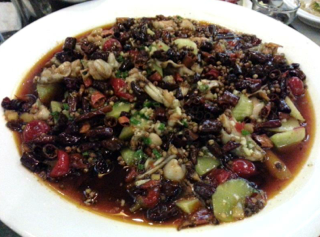By Angela Jin
Growing up in a Chinese family, it is no wonder that I partake in Chinese cuisine. There is the standard fare of rice and noodles, though ‘standard’ gives the wrong impression that there is only one version of each. There is also a variety of dumplings and buns, usually stuffed with meat and/or veggies, and in the case of the buns, occasionally contain a sweet center. These staples of the Chinese meal are accompanied by a multitude of dishes, which may consist of meat, seafood, vegetables, fruit…anything and everything imaginable. Here, in Beijing, China, the truth of that phrase is proven each and every day.
While walking down 南锣鼓巷 (Nanluoguxiang), a street filled with shops, stands and, of course, people, you can not only buy any kind of souvenir imaginable, but you can also discover a lot of the typical street food of Beijing. There are the typical skewers of chicken, lamb and octopus, although these can be abnormal in that they can reach two feet long in length, as well as skewers of crabapples and other fruits covered in a sugar glaze. You can also buy boiled balls made from fish, cuttlefish, sea urchin, crab, and many other types of sea creatures, as well as the snack 臭豆腐 (choudoufu), commonly translated to “stinky tofu.” You can purchase the Beijing specialty drink 酸奶 (suannai), a delicious liquid similar to yogurt, and juice smoothies of strawberry, melon, corn, papaya, and more. Some stores even sell churros, cotton candy and Japanese snacks, attempting to attract customers with their foreign products. But one of the more interesting foods you can find here is from Beijing itself: fried insects.


For reasons I cannot fathom, consuming insects does not seem to faze the people of Beijing (or China, for that matter). While I can understand the practicality of eat these things, which possess a high nutritional value, I would never actually do it; the idea of crunching down on one, with its many legs…I shudder just thinking about it. The shop was even selling fried scorpions, which makes me wonder whether their venomous stingers were even removed. This particular shop was also selling fried starfish, which one of my friends decided to try. He decided it wasn’t quite worth the purchase.
The snacks of Beijing are not the only weird food to be found. Last night my Foreign Study Program group ate at a restaurant that, like many others in Beijing, served sea cucumbers, birds’ nests (which are the actual nests), and frog, among other delicacies. As you can see below, we ordered a dish of frog legs. It was a little disconcerting, to say the least, to see their little toes and limbs. However, I must add, the meat was quite tender. And as to whether or not it does actually taste like chicken, I am sorry to say (or perhaps not so sorry) that the dish was too spicy for me to taste anything. Perhaps you can try frog yourself one day and tell me. Would you eat it?


Note: All photos taken by me












